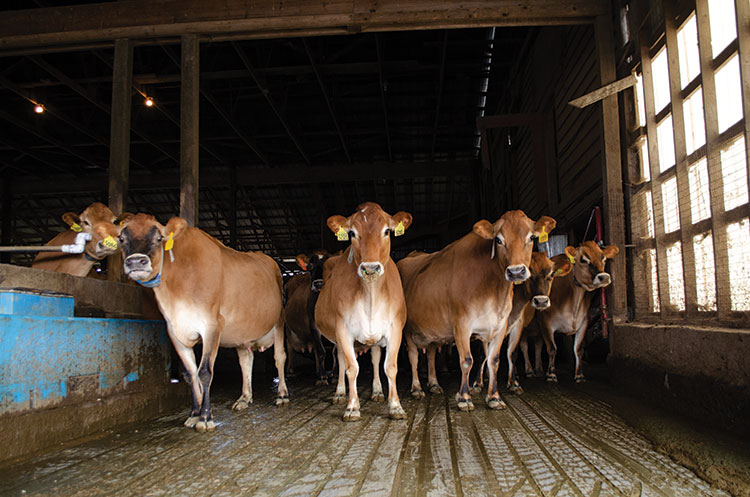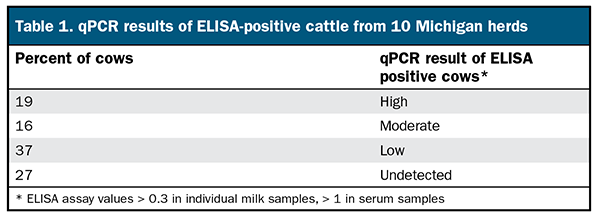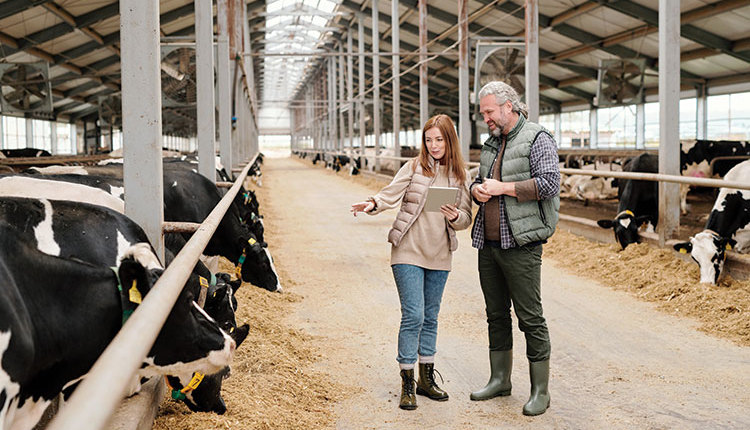The authors are a former master’s degree student and a senior extension educator, respectively, at Michigan State University.

Bovine leukemia virus (BLV) infects approximately half of all dairy and beef cattle in North America. Herd owners and managers may wonder whether it is a disease they should fight, and if so, is it a battle they can win?
BLV is untreatable and incurable, and no effective vaccines exist for protection against BLV. However, BLV is a preventable disease. The virus infects white blood cells, thus it is a blood-borne pathogen. Infection by BLV leads to the development of enzootic bovine leukosis, which can have detrimental effects on animal well-being and lead to downstream financial losses. Because BLV impacts the well-being of cattle, infected cattle are ripe to become a consumer issue with potentially major repercussions for both the milk and meat industries.
Cattle infected with BLV can experience a range of symptoms including a weakened immune response, raising the risk of infection by opportunistic pathogens. Researchers at Michigan State University have found evidence that infected animals have a greater risk of leaving the farm earlier than their herdmates. Financial loss due to BLV infection is reflected in premature culls, greater death rate of infected cows, higher risk of condemnation at slaughter, and less overall lifetime milk production.
Test to find problem cows
The most commonly used test for BLV is analysis of serum or milk by enzyme-linked immunosorbent assay (ELISA). BLV ELISA tests for the presence of specific antibodies against BLV. Antibodies are likely present if an animal has been infected by the virus, or in a calf that has antibodies from a maternal source.
Antibody presence is an indirect test for BLV. While ELISA testing is an accurate and cost-effective method for detecting the presence of BLV in the herd, it doesn’t distinguish cows that are at a greater risk of spreading the disease to others.
CentralStar Cooperative’s research and development team developed an assay (the SS1 qPCR assay) that can accurately quantify the concentration of provirus circulating in an individual animal, identifying the BLV super-shedders. The test compares the ratio of viral DNA relative to host DNA, the proviral load, in a blood sample, with the results reported as the ratio between viral and host DNA copies. For example, a test result of 2 suggests that there are twice the number of BLV copies than copies of the cow’s own DNA within a sample.
Proviral load results are interpreted based on the ratio. Results with a ratio of greater than 1 are designated as “high,” for there is as much, or more, virus DNA as host DNA. Results of 0.5 to 1 are interpreted as “moderate,” and results less than 0.5 are termed “low.” The test may also return results as “no virus detected” even in an animal with a positive ELISA assay. Past research has shown that these cows are not infectious to their herdmates.
In a study of 10 low-prevalence herds (Table 1), 75 qPCR tests were run on cows that were ELISA-positive. The results showed that 72% of the cows had detectable provirus. Of those cows, 19% had high levels of provirus, 16% were moderate, and 37% had a low level of provirus.

Time to take action
The identification of high-shedding cows by the SS1 PCR test provides a producer an effective, affordable method to identify the cows that are most infectious to the herd, facilitating the development of strategies to reduce the prevalence of BLV. A cattle producer, either dairy or beef, can use qPCR results to make more rapid impact on BLV prevalence by separating or culling cows with a high proviral load. Cattle with a high proviral load, or super-shedders, are the major cause of spreading the virus within the herd. Whatever protocol you decide upon, acting on the information is important.
Some producers have established a response protocol based on these results, as shown in Table 2. This protocol recognizes that it is important to remove super-shedders from the herd to control the rate of new BLV infections.

For dairy producers who have not previously performed BLV testing, Michigan State University Extension recommends beginning with a Herd Profile ELISA Test of 40 animals. Milk or blood sampling of the 10 most recently fresh cows of first, second, third, and four or more lactations is well correlated with the overall herd prevalence. Milk testing can be conveniently performed using regularly collected Dairy Herd Information Association (DHIA) samples. A producer can identify where they stand and implement a transmission control program based on that knowledge.
However, to make individual animal decisions, the SS1 qPCR results are essential to distinguish the super-shedders from other cows. It is likely that more cows will have a positive ELISA test than are an immediate risk to the rest of the herd. Some herd owners may find that the herd prevalence is high with a significant number of high shedders. While it is not possible to cull all high animals at once, the relative ratio can be used to target the most contagious animals, and that’s a place to start a control program.
Stop the transmission
Reducing the opportunity for transmission is important no matter what culling or breeding strategy is applied. Transmission is the fuel that keeps BLV in the herd and, unless controlled, will result in more culls, take longer to control, and further elevate costs. Ignoring BLV only allows it to grow in prevalence and is a short-sighted response relative to increasing consumer concerns.
While controlling BLV is a long-term process, using SS1 qPCR results enables producers to cull the animals most likely to harbor and spread the disease in the herd. ELISA provides the scope of the fight; SS1 qPCR enables you to win it. This is a fight for your cattle and, ultimately, a fight for the industry.









